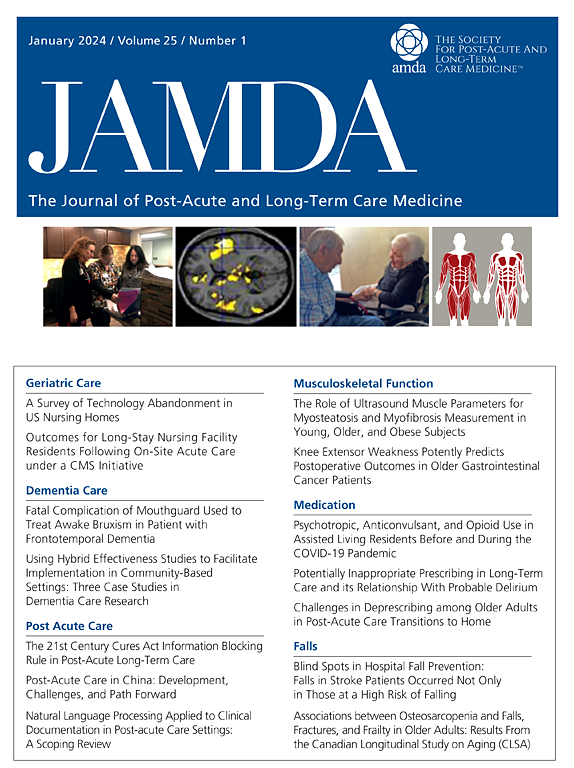辅助生活设施新住户的临床和社会人口特征:一项嵌套病例对照研究。
IF 4.2
2区 医学
Q2 GERIATRICS & GERONTOLOGY
Journal of the American Medical Directors Association
Pub Date : 2024-09-20
DOI:10.1016/j.jamda.2024.105270
引用次数: 0
摘要
目的研究接受政府资助的家庭护理服务的社区老年人向生活辅助设施的过渡:设计:嵌套病例对照研究:从 2018 年 4 月 1 日至 2019 年 12 月 31 日期间,从加拿大安大略省接受家庭护理服务的 65 岁及以上成年人处获得了关联的人口级卫生系统行政数据。根据年龄、性别和开始接受家庭护理的日期(± 7 天),将辅助生活的新居民与社区居住的家庭护理接受者按 1:4 的比例进行匹配:对临床和功能状态、医疗服务使用情况、社会人口学变量和社区层面的特征进行了研究;使用条件逻辑回归建立了过渡到辅助生活设施的关联模型:共有 2427 名新入住辅助生活设施的居民,他们与 9708 名家庭护理对象(平均 [SD] 年龄为 85.5 [6.02] 岁,72% 为女性)进行了配对。大多数新居民集中在城市社区和收入较高的社区。新居民经医生诊断患有痴呆症(调整后危险比 [aHR],1.28;95% CI,1.14-1.43)、情绪障碍(aHR,1.17;95% CI,1.05-1.29)和心律失常(aHR,1.19;95% CI,1.07-1.32)的比例较高。他们患有轻度认知障碍(aHR,1.43;95% CI,1.24-1.66)、2 次或以上跌倒(aHR,1.29;95% CI,1.11-1.51)、过去 7 天内参加长期感兴趣的活动(aHR,1.29;95% CI,1.11-1.50)的比例也较高,配偶或伴侣无偿照顾者与子女相比比例较低(aHR,0.66;95% CI,0.56-0.79):辅助生活设施的新住户大多为女性,认知能力受损,患有可能增加其受伤风险的临床合并症,其护理人员为其子女。这些发现强调了提高生活辅助设施中的记忆和痴呆症护理水平以满足这类人群需求的重要性。本文章由计算机程序翻译,如有差异,请以英文原文为准。
Clinical and Sociodemographic Characteristics of New Residents of Assisted Living: A Nested Case-Control Study
Objective
To examine transitions to an assisted living facility among community-dwelling older adults who received publicly funded home care services.
Design
Nested case-control study.
Setting and Participants
Linked, population-level health system administrative data were obtained from adults aged 65 years and older who received home care services in Ontario, Canada, from April 1, 2018, to December 31, 2019. New residents of assisted living were matched on age, sex, and initiation date of home care (± 7 days) to community-dwelling home care recipients in a 1:4 ratio.
Methods
Clinical and functional status, health service use, sociodemographic variables, and community-level characteristics were examined; conditional logistic regression was used to model associations with a transition to an assisted living facility.
Results
There were 2427 new residents of assisted living who were matched to 9708 home care recipients [mean (SD) age 85.5 (6.02) years, 72% female]. Most of the new residents were concentrated in urban communities and communities with higher income quintiles. New residents had an increased rate of physician-diagnosed dementia [adjusted hazard ratio (aHR), 1.28; 95% CI, 1.14–1.43], mood disorders (aHR, 1.17; 95% CI, 1.05–1.29), and cardiac arrhythmias (aHR, 1.19; 95% CI, 1.07–1.32). They also had higher rates of mild cognitive impairment (aHR, 1.43; 95% CI, 1.24–1.66), 2 or more falls (aHR, 1.29; 95% CI, 1.11–1.51), participation in activities of long-standing interest in the past 7 days (aHR, 1.29; 95% CI, 1.11–1.50), and a lower rate of a spouse or partner unpaid caregiver vs a child (aHR, 0.66; 95% CI, 0.56–0.79).
Conclusions and Implications
New residents of assisted living were mostly women, were cognitively impaired, had clinical comorbidities that could increase their risk of injuries, and had caregivers who were their children. These findings stress the importance of upscaling memory and dementia care in assisted living to address the needs of this population.
求助全文
通过发布文献求助,成功后即可免费获取论文全文。
去求助
来源期刊
CiteScore
11.10
自引率
6.60%
发文量
472
审稿时长
44 days
期刊介绍:
JAMDA, the official journal of AMDA - The Society for Post-Acute and Long-Term Care Medicine, is a leading peer-reviewed publication that offers practical information and research geared towards healthcare professionals in the post-acute and long-term care fields. It is also a valuable resource for policy-makers, organizational leaders, educators, and advocates.
The journal provides essential information for various healthcare professionals such as medical directors, attending physicians, nurses, consultant pharmacists, geriatric psychiatrists, nurse practitioners, physician assistants, physical and occupational therapists, social workers, and others involved in providing, overseeing, and promoting quality

 求助内容:
求助内容: 应助结果提醒方式:
应助结果提醒方式:


